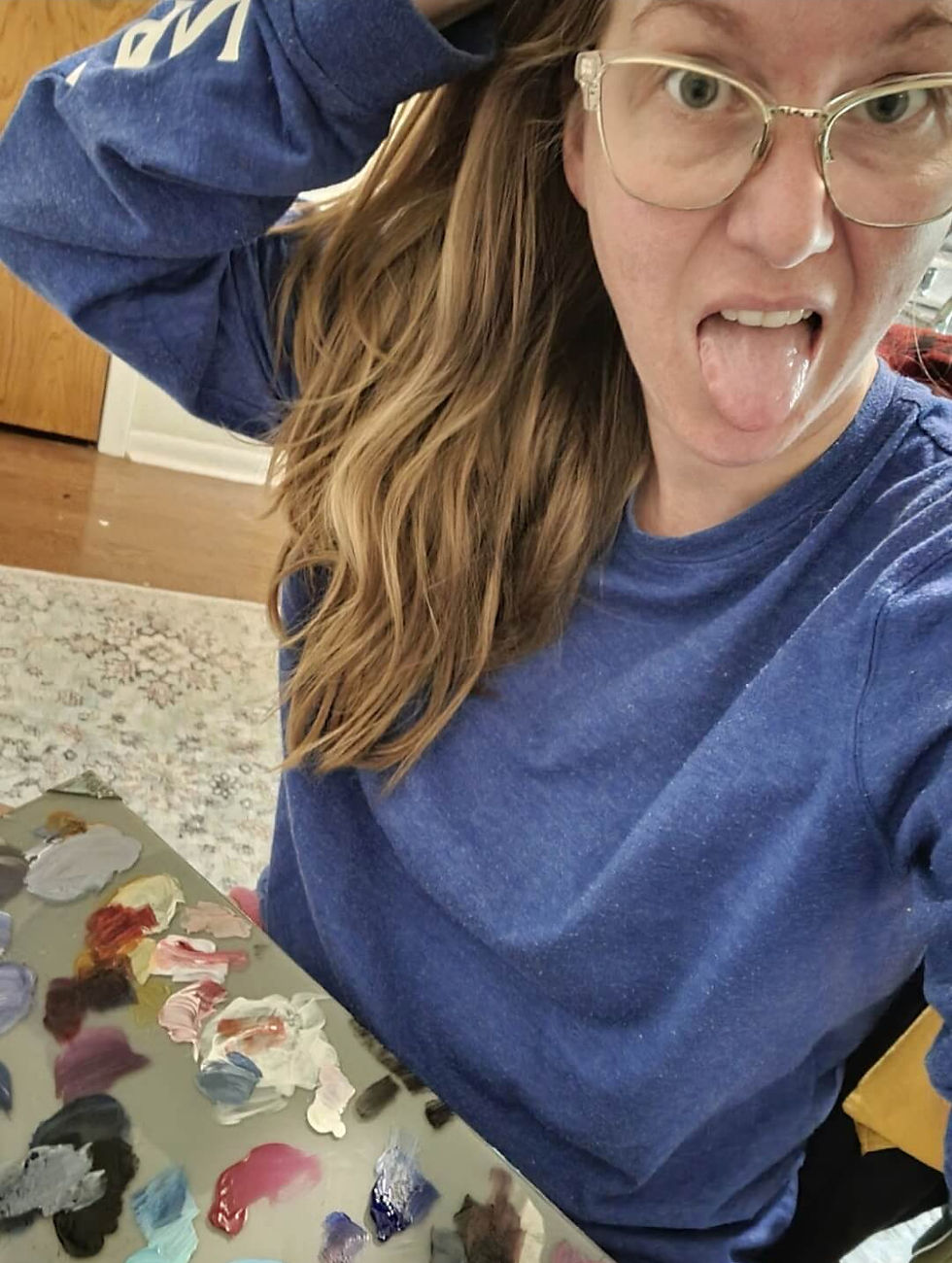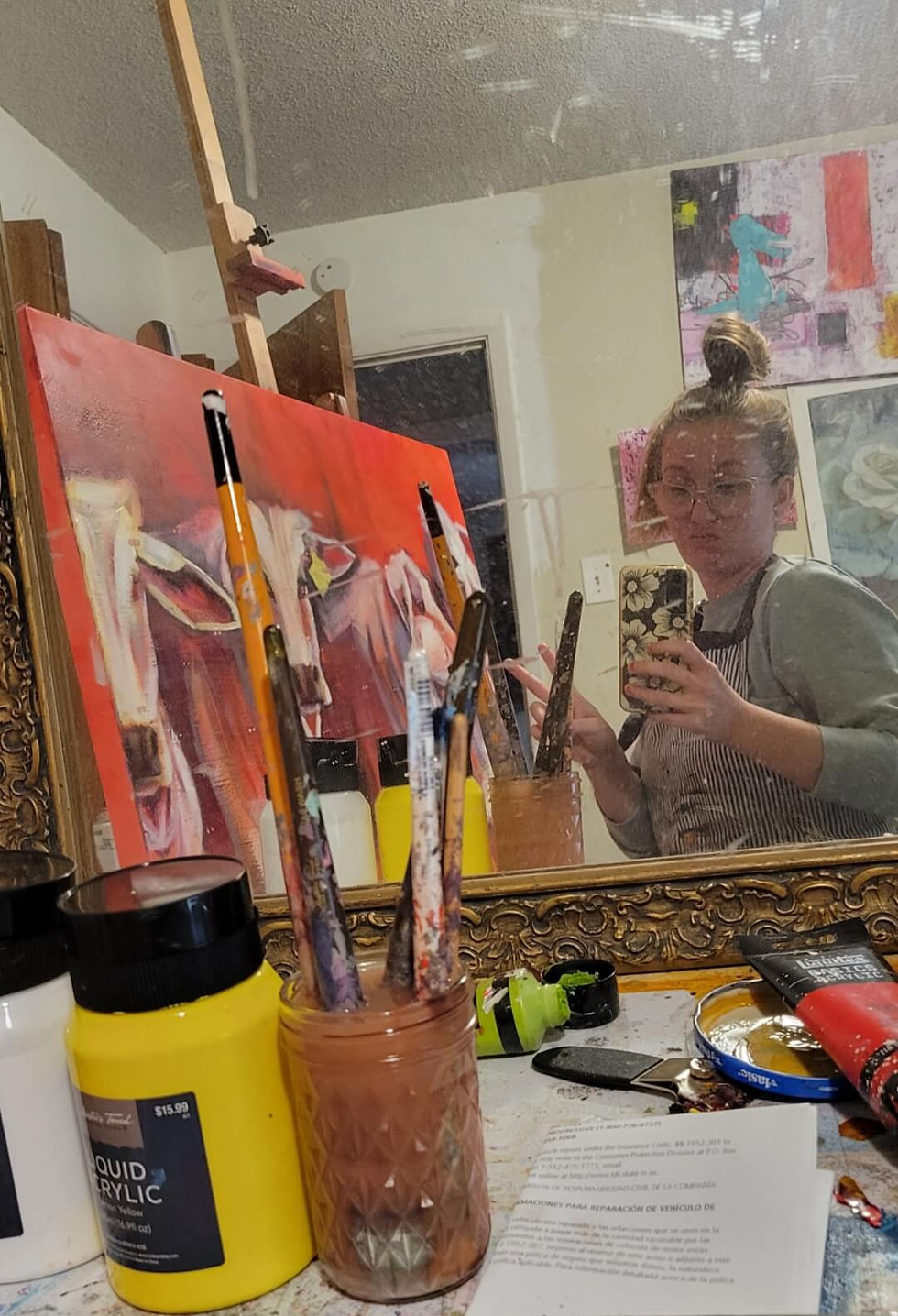Finding My Artistic Voice: The Evolution of My Process
- Mandi Murphy
- Mar 28
- 4 min read
Updated: Apr 22
I want to let you in on the process of how I create my art. As a relatively new professional artist who only started selling paintings about a year ago, you might notice different art processes or materials used in some of the earlier pieces of my collections. Over the past two years, I've been on a mission to find my artistic style and voice—what was going to be my niche in the art community.

I've experimented with everything: collage, different mediums, painting hyper-realistic, trying out abstract, and throwing anything and everything at a canvas that will stick. But more recently, I've come to a revelation that an artist's style is ever-evolving. I don't need to put a label on myself and box me in. I don't need to find a niche. I just need to be myself.
Things become too boring once you've "got it all figured out." Because of this revelation, play and discovery have become central to my process. So while I can't tell you definitively what my process will always be as far as materials (although I will tell you what I'm using right now 😉), I can lead you up and down on this artistic cycle I tend to follow between making new pieces.
My Creative Cycle
Let's say that over the last two months I have just finished up seven paintings that I planned out and executed. The varnish is drying, the wire is attached to the back, and they have all been signed. What's next? Where am I going to go from here?

This is where, for the next two weeks, I research. Research for me looks a lot like me just playing around in my studio. I don't have any plans or subject matter in mind, but I am adding layers of paint to two or three canvases. My goal is just abstraction at this point. Many times, one or two of these paintings might be the starting ground for a piece in my next series. Sometimes I come out of it with a really good abstract, but a lot of the time I just get to remember what I love so much about being in my studio.
During this time that I'm playing, I am also spending just as much time on my computer sifting through stock photos or looking around at nature outside. I'm trying to find imagery that grabs me. Maybe it's an animal in a strange pose, a color palette, or the herd of cows in the field next door. I am looking for some cohesive imagery or story I can pull through my next set of paintings.
Once I have a few ideas, I make a ton of mock-up paintings in Procreate on my computer. Some of these mock-ups will become sources for my upcoming series! I always start with the ones that I am most excited about.
My Painting Process
Then it's time to finally start painting! So what do I use and how do I blend abstract with realism but still make the piece look cohesive?
For me, it's all about this push and pull between the background and the subject. There is a give and take that happens between the layers where the image is often lost but will start to emerge back only to lose parts again until, in the end, they both meld together seamlessly.

I like to start out with the furthest depths of the painting. I apply inks and spray paints until I get the right colors and tones. I love any beautiful accident that occurs when working with the very unpredictable inks. Then I like to do something that most people find a little strange—I add lots of powdered charcoal to make the blacks in the painting. It just comes off so much richer to me than black paint.
I also LOVE using a roller at this point. It is a great way to get little bits of the color all over the canvas and create some nuance. I hardly ever use a paintbrush at this stage because I'm trying to be as loose as possible. This portion of the painting may take me three or four 30-minute sessions, or I may get it right the first time. This is when the hair dryer comes in clutch to get it dry and ready for all those new applications of paint.
I know when it's ready for the next step because, like magic, the abstractions will already start to look like imagery meant to be in the painting.
The next step is to draw in the main subject matter, and I love to use just charcoal and white paint for this. It is a fun blend of drawing and painting that gives me the accuracy that I want while still retaining a looseness about it. Acrylic paints are brought in more to define certain areas while also making sure not to cover up all the beauty from the first layer and only to enhance it.
Once I'm done with acrylic, I often feel like the bones of the painting are complete. All the structure is there, and it takes the oil paint I use in the end to really make it all come to life. I use lots of glazes to up the contrast over the entire painting, but it is usually only the main subject area that gets the opaque paint.
The Final Result

The end result is a beautiful mixed media painting with abstraction and realism that creates its own little world on canvas. It can feel like walking a tightrope at times, making sure that I render out the subject matter well enough but still allowing the background to shine through. But it is always the most amazing experience.
If you're interested in seeing more of my process, follow me on Instagram for time-lapse videos or subscribe to my newsletter for an in-depth look.
Love, Mandi




Comments